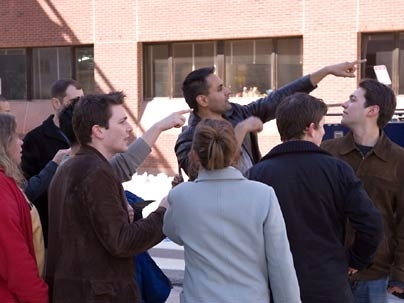The negotiations taking place in the windswept East Campus courtyard were tense and going badly. As the Sharks considered trading keys with the Dolphins to unlock the box in the courtyard, suspicions were running high.
"You guys are vicious," one Dolphin said.
"We got cheated already," a Shark complained.
The Dolphins had opened just five of the 10 boxes needed to win "The Hunt," a new Sloan Innovation Period (SIP) course held on Wednesday, March 21. The Sharks already had nine items, one item from each box they'd opened during the three-hour scavenger hunt that called for 7-member teams to follow picture clues, barter for scarce keys and solve a rebus puzzle as a final competitive challenge.
The Dolphins felt the tide turning against them. "If you want to kick us while we're down, there's some sand here," said John Clingan (M.B.A. '08), his team's lead negotiator.
In the end, keys were swapped and everyone got a little bit closer to winning the scavenger hunt. At the same time, students gained some first-hand experience in team-building, problem-solving and negotiating under pressure--which was the over-arching goal of the new SIP activity.
SIP, an annual week of workshops and leadership training, offers a break in routine for M.B.A. students halfway through each semester at the MIT Sloan School of Management. This year's courses, held March 19-23, included "The Hunt" as well as "Design-Inspired Innovation," "What's Your Leadership Style?" and "The Future of Work."
"The Hunt" attracted a capacity enrollment of 70 students. "It just sounded interesting and a little bit more active," said Shivani Garg (M.B.A. '08) about why he signed up. "I think everyone is kind of excited about it."
The Sharks emerged victorious. Although only the third team to return to Wong Auditorium with an item retrieved from each box, the Sharks made it to first place by succeeding in the second task in the game--solving a rebus riddle using the items.
Members of the Sharks credited their success to their cooperative spirit. "We shared information freely" and worked hard on developing goodwill, said Dong Kim (M.B.A. '08).
Wait a minute, the Sharks were the nice ones? They weren't vicious?
In the discussion that followed the game, led by Jonathan Lehrich, associate director of the MIT Leadership Center, students revealed that many teams had felt deceived. But the "lies" turned out to be innocent misunderstandings. One student, for example, had been so close to a box it was simply incredible to others that he hadn't seen it.
"Time and competition reduce trust quickly," Lehrich said.
"The Hunt" was organized and presented by the MIT Leadership Center. Run by Noah Schneiderman (CP 2002), president of NRS Consulting, it's often used as a team-building exercise within companies. The dynamics are a little different when there is an existing hierarchy, Schneiderman said.
"If you have a team and the CEO is on the team or the head of a department is on the team, you know that team is going to lose," he said. Why? The boss tends to go it alone without tapping into the strengths of others.
The MIT Sloan students came into the game on a more-or-less equal footing, but there were still team members who fell into line behind more dominant types.
Perhaps in the end, the cooperative spirit wasn't all the Sharks had going for them. Teammates also said that everyone took on leadership roles, and they communicated well with each other. "Everyone's strengths came out," said Ryan McDonald (M.B.A. '08).
A version of this article appeared in MIT Tech Talk on April 4, 2007 (download PDF).








